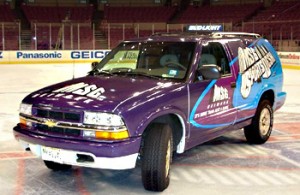Design work for vehicle wrapping is much different than design work for flat  graphics or banners or any other vinyl application, according to experts, and preparing vehicles for installation is critical to the appearance and life of the wrap.
graphics or banners or any other vinyl application, according to experts, and preparing vehicles for installation is critical to the appearance and life of the wrap.
In part one of this series, we discussed the benefits of venturing into vehicle wrapping and the materials and tools you would need to jump aboard this skyrocketing trend. In this article we will look at the ins and outs of designing for wraps and how to best prepare the vehicle for installation.
Knowing the vehicle
Knowing the shape and size of the vehicle and all its nuances is a critical part of the design process; therefore, taking measurements before you do any design work is a must.
“You really have to have a good handle on templates,” says Peter Bearth, director of Spectrum Media Group in Dallas, a division of J Perez Associates. “Templates are so key because positioning is critical. If you have to do a lot of reprints, then that could break your business.”
Experts also recommend an auto library that contains vector images of cars, trucks and buses and a digital camera with which to take pictures. The goal is to know every inch of the vehicle. If you don’t take time to do this up front, then you could end up with text over a door handle. Even though you are wrapping a 2003 Dodge Caravan, for example, measurements are still important because there are slight differences that could cause major problems during installation.
Designing for wraps
“Designing for wraps is completely different than other types of design work,” says Manuel Vicnansky, president of DeSignCo in Miami. “It’s like any new media, you have to learn the media and you have to learn what is going to capture the attention of the people. It’s more than just putting graphics on a car.”
Vicnansky suggests avoiding using too much text or colors. He says many people are using rainbows on cars and that causes the intended viewer to miss the message. In fact, making a bold statement is one of the biggest challenges in designing for wraps.
“You have to keep it simple. You need a strong message. You only have a few seconds to get the message across as the car passes by,” says Vicnansky. “It’s a branding media; it’s not a message media. You just show the brand for recognition more than to run a brochure.”
Keeping it simple
Bearth says one of the biggest mistakes with wrap designs is going overboard with flashy graphics or trying to put a one-dimensional design on a three-dimensional vehicle.
“Normally where your hood and your front bumper transition to the side of the car is challenging,” says Bearth. “You are basically laying down a flat design on the hood and a flat design on the side of the vehicles and if you have a wacky design, then they don’t transition well on either side of the hood and on either side of the trunk on the back.”
Bearth recalls doing a big push for an Internet company’s new sports portal. The design consisted of hundreds of tennis balls to be installed on a Jeep CJ-7. But the one-dimensional design did not transition well on the three-dimensional vehicle.
“The designer kept looking at the wrap and saying ‘That’s not what I wanted’,” says Bearth. “So we told him he would have to make adjustments to the design. When clients try to get too fancy, the trick is getting them to give you a solid color so that there are not lots of lines or matching up to do.”
As seen on signindustry.com.


